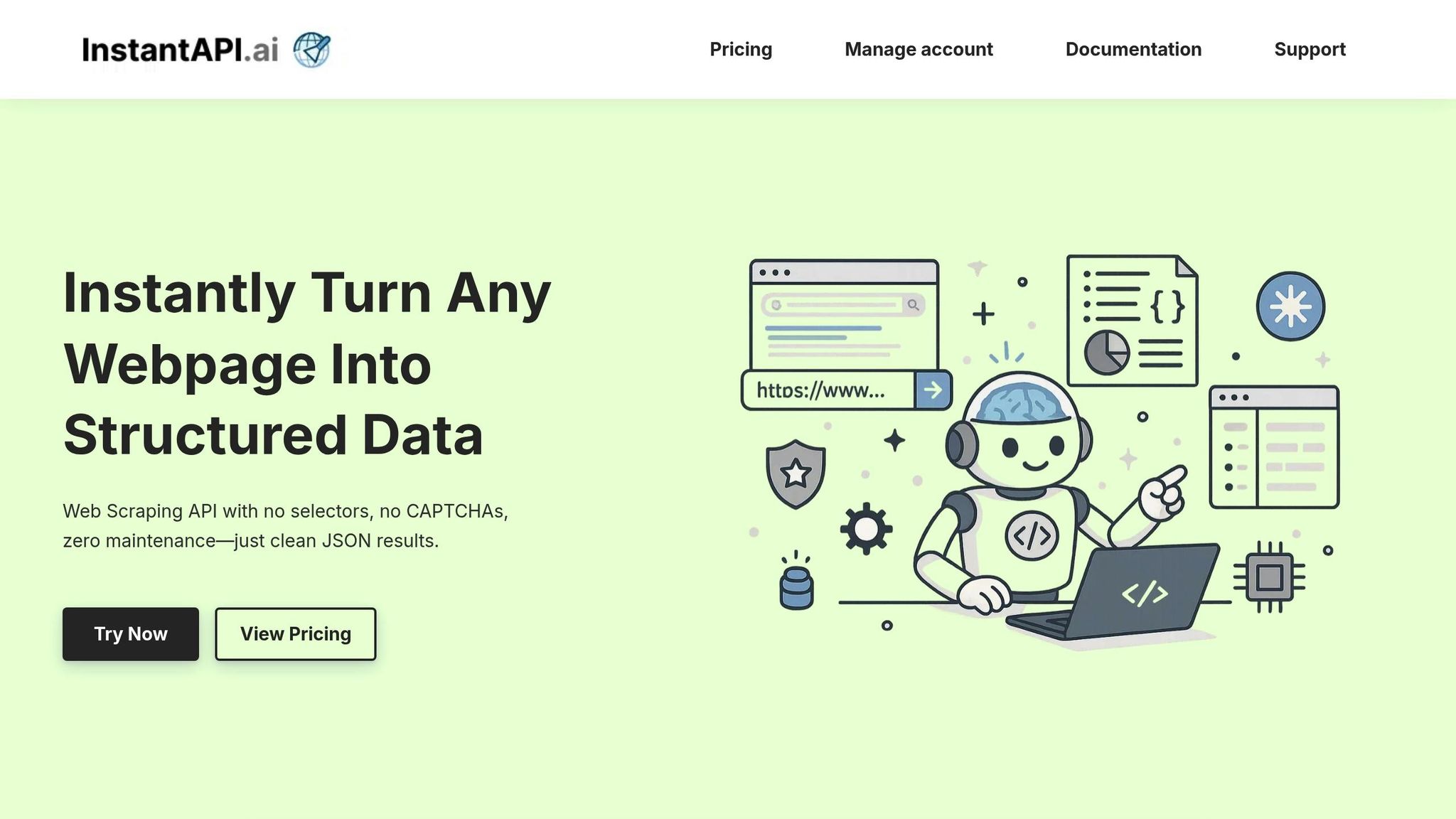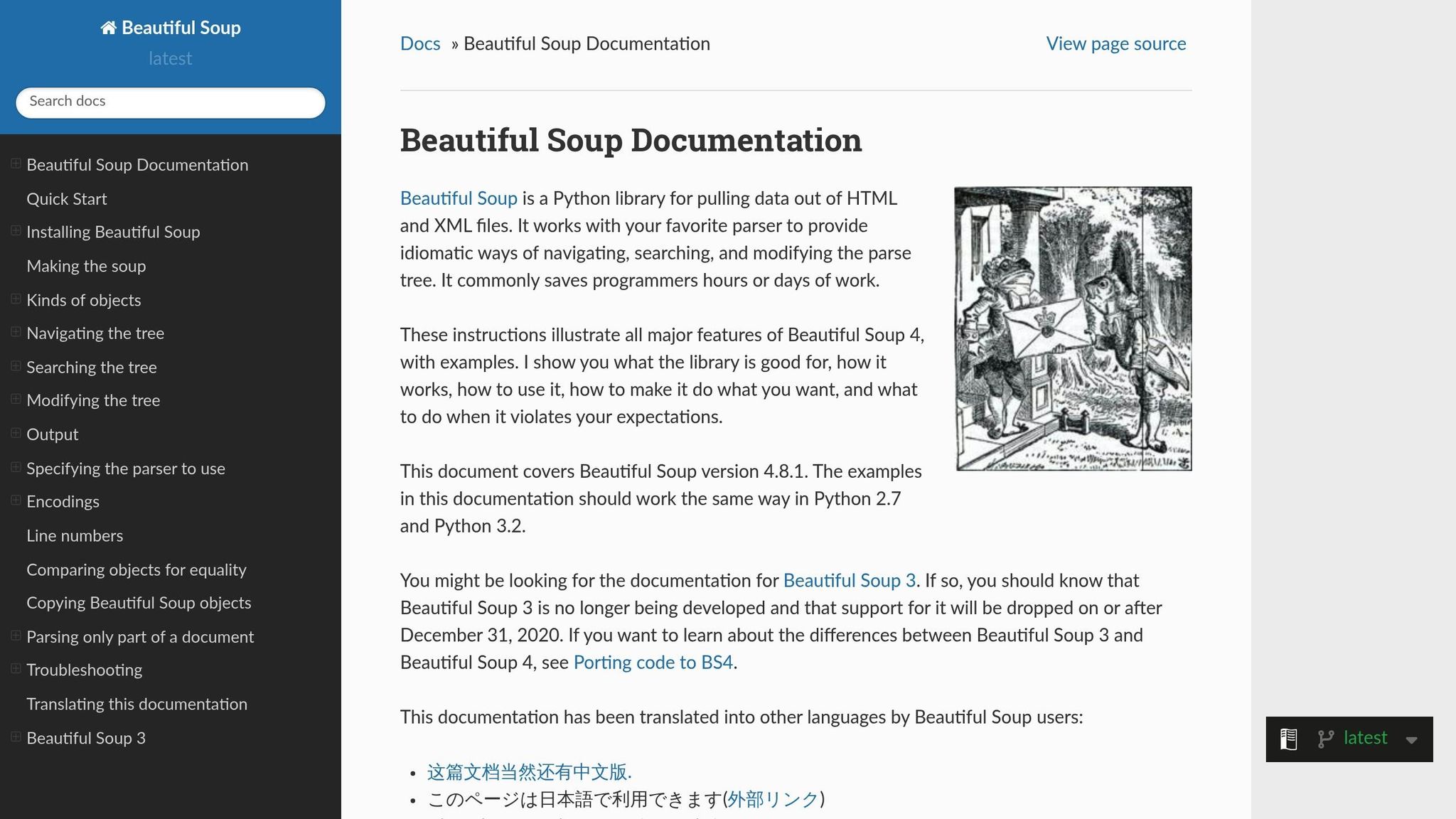Web scraping is changing the way we forecast financial markets by automating real-time data collection. Here's how it works and why it matters:
- What it Does: Gathers data from financial websites, market platforms, and databases to create structured datasets for analysis.
- Why it Matters: Provides traders and analysts with real-time insights for better decisions.
- Key Data Types:
- Stock prices for quick market reactions.
- Economic indicators for long-term trends.
- Company financials for risk assessment.
- Market sentiment for short-term price predictions.
- Tools You Can Use:
- InstantAPI.ai for automated scraping with high accuracy.
- Beautiful Soup for static data.
- Scrapy for large-scale data collection.
- LSTM and ARIMA models for trend forecasting.
Quick Overview of Web Scraping Benefits:
| Aspect | Impact |
|---|---|
| Real-time data | Faster market reactions |
| Automated collection | Saves time and effort |
| Accurate predictions | Improves decision-making |
| Global data coverage | Broader market insights |
Takeaway: Web scraping is a powerful tool for financial forecasting, helping analysts stay ahead with precise, automated data collection and advanced predictive models.
Web Scraping Financial News using Python
Required Financial Data Types
This section dives into the essential types of financial data and where to find them, building on the role of scraped data in financial forecasting.
Financial Data Categories
Forecasting relies on a mix of data sources, such as stock prices, financial statements, ratios, economic indicators, and market sentiment. By 2020, the alternative data market had grown to $1.72 billion, reflecting the growing demand for diversified data.
Here’s a breakdown of key financial data categories:
| Data Type | Description | Impact on Forecasting |
|---|---|---|
| Stock Prices | Live and historical pricing data | Fundamental for trend analysis |
| Financial Statements | Includes income statements, balance sheets, and cash flows | Helps assess company performance |
| Financial Ratios | Metrics like P/E ratios, EPS, and market cap | Used for company valuation |
| Economic Indicators | Data like GDP, unemployment, and inflation | Provides macroeconomic context |
| Market Sentiment | News headlines and social media reactions | Influences short-term price trends |
Finding Data Sources
Accurate forecasting depends on trustworthy data sources. For example, SEC EDGAR provides real-time, standardized filings, making it easier to analyze financial statements consistently.
Here are some major financial data sources:
| Source | Available Data | Update Frequency |
|---|---|---|
| SEC EDGAR | Standardized XBRL filings since 2009 | Real-time updates |
| Yahoo Finance | Stock prices and market indicators | Live updates |
| Federal Reserve (FRED) | Economic indicators and interest rates | Daily or weekly |
| Company IR Pages | Earnings reports and presentations | Quarterly |
Key metrics to monitor include:
- Previous close price
- Opening price
- Daily trading range
- 52-week range
- Market capitalization
- P/E Ratio (TTM)
- EPS (TTM)
In April 2025, the SEC revealed a $91 million Ponzi scheme involving three individuals from Texas (Source: SEC.gov, April 29, 2025). This case highlights the critical need for accurate financial data collection and verification to protect investors.
Reliable sources like these provide a strong foundation for effective web scraping and seamless data integration.
Web Scraping Methods
Different websites require specific scraping techniques depending on how they display their information.
Handling Various Web Content
The scraping method you use depends on how the financial data is presented. For example, static content like basic stock listings can be handled with straightforward HTML parsing. On the other hand, real-time market data often requires more advanced techniques, such as simulating user interactions or waiting for content to load.
| Content Type | Best Approach | Typical Use Case |
|---|---|---|
| Static HTML | Use BeautifulSoup for parsing | Historical stock prices, company profiles |
| Dynamic JavaScript | Leverage Selenium for scraping | Live market data, trading volumes |
| AJAX Updates | Automate with browser tools | Real-time price updates, market indicators |
Dynamic content often requires additional steps, such as simulating user actions or introducing wait times, to ensure accurate extraction.
Avoiding Scraping Blocks
Financial websites often use defenses like IP blocking, rate limiting, and CAPTCHAs to protect their servers. A well-structured approach to scraping can help bypass these obstacles while maintaining access reliability:
| Challenge | Solution | Implementation |
|---|---|---|
| IP Blocking | Rotate IP addresses | Use multiple proxy servers |
| Rate Limiting | Add delays between requests | Insert 2-3 second intervals |
| CAPTCHAs | Mimic user behavior | Use browser fingerprinting tools |
These strategies help ensure consistent and efficient data collection without triggering website restrictions.
Setting Up Automated Collection
To optimize data scraping, schedule your collection based on key factors:
- Market Hours: Focus on NYSE trading hours (9:30 AM - 4:00 PM EST) for primary data collection.
- Earnings Seasons: Increase scraping frequency during quarterly reporting periods.
- Economic Calendar: Align scraping with major economic announcements.
Adjust request frequency based on market activity. For instance, during volatile periods, you may need to increase the collection rate to capture rapid price changes while adhering to access policies.
InstantAPI.ai simplifies this process with automated scheduling and built-in rate-limiting tools. These features ensure efficient, policy-compliant data capture while keeping up with market timing requirements.
Data Collection Tools
Selecting the right tools can significantly improve the accuracy of financial forecasting. Below are some of the top tools for gathering financial data effectively.
InstantAPI.ai Features

InstantAPI.ai specializes in extracting financial data with precision. It uses headless Chromium rendering and supports geotargeting in over 195 countries, ensuring broad market coverage. The platform also offers features like rotating IPs, CAPTCHA handling, customizable output formats, and high concurrency, making real-time data collection smooth and efficient.
| Feature | Benefit for Financial Data | Implementation |
|---|---|---|
| Rotating IPs | Avoids blocking during market hours | Automatically switches proxies across regions |
| CAPTCHA Handling | Ensures uninterrupted data flow | AI-powered solving with human-like behavior |
| Custom Output | Standardizes financial data | Exports data using a defined JSON schema |
| Concurrency | Speeds up real-time data gathering | Handles parallel requests at just 0.5¢ per page |
"After trying other options, we were won over by the simplicity of InstantAPI.ai's Web Scraping API. It's fast, easy, and allows us to focus on what matters most - our core features." - Juan, Scalista GmbH
Beautiful Soup and Scrapy Uses

Beautiful Soup is perfect for parsing straightforward financial data, such as static price tables or company profiles. Its user-friendly API makes it ideal for smaller, focused tasks.
On the other hand, Scrapy is better for large-scale data collection. Its built-in capabilities include:
- Handling asynchronous requests for up-to-date market data
- Managing proxies automatically for high-volume scraping
- Exporting structured data for deeper financial analysis
For websites that require interactive sessions, browser automation tools become essential.
Browser Automation Tools
Headless browsers streamline tasks such as:
| Automation Task | Purpose | Common Application |
|---|---|---|
| Session Management | Keeps users logged in | Accessing password-protected financial portals |
| Dynamic Content | Waits for AJAX-loaded updates | Monitoring real-time stock tickers |
| Form Submission | Automates data queries | Searching for historical price data |
InstantAPI.ai’s use of headless Chromium ensures a success rate of over 99.99% in extracting data from complex financial websites. This eliminates the hassle of manually setting up and maintaining browser automation tools.
sbb-itb-f2fbbd7
Data Preparation Steps
Thoroughly preparing financial data is essential for generating reliable and actionable forecasts.
Data Cleanup Methods
Address common data issues to ensure consistency and accuracy:
| Data Type | Common Issues | Cleanup Method |
|---|---|---|
| Stock Prices | Missing decimal points, wrong multipliers | Format prices to 2 decimal places |
| Trading Volume | Inconsistent formats (K, M, B) | Convert all values to actual numbers |
| Dates | Mixed formats (MM/DD/YY, DD-MM-YYYY) | Standardize to MM/DD/YYYY format |
| Currency Values | Mixed symbols ($, €, ¥) | Convert to USD using daily exchange rates |
For time-series financial data, follow these key steps:
- Normalization: Use Min-Max scaling to bring values into a consistent range.
- Handling Missing Data: Fill gaps spanning a few trading days with linear interpolation.
- Feature Engineering: Add derived indicators to improve forecasting, such as:
- 10-day moving averages
- Price momentum indicators
- Trading volume trends
- Volatility measures
Once cleaned, validate the data with error checks to ensure integrity.
Finding Data Errors
After cleaning, it's essential to detect and fix any remaining anomalies for accurate analysis.
| Error Type | Detection Method | Resolution Approach |
|---|---|---|
| Outliers | Z-score > 3 or IQR method | Cross-check with alternative sources |
| Duplicate Entries | Hash comparisons | Remove duplicates, keeping the latest record |
| Stale Data | Timestamp analysis | Update with current market data |
| Format Issues | Regular expression validation | Standardize formats |
"In finance, data acts as the new oil, powering investment strategies, risk management, and market predictions." - PQN
For real-time market data, apply these validation checks:
-
Statistical Verification
Calculate daily descriptive statistics to identify unusual price movements, volume spikes, or missing trading periods. -
Time Series Integrity
Ensure data aligns with market hours, expected non-trading days, and accounts for corporate actions when applicable. -
Cross-Reference Validation
Compare data against multiple trusted sources, such as Bloomberg or Reuters, to catch discrepancies and flag them for manual review.
Using Data in Forecasting
Turn cleaned data into predictions using advanced forecasting models. After cleaning, these models analyze the data to provide actionable insights.
ARIMA Model Setup
ARIMA models are effective for identifying time-series trends in stock prices and market indicators. The model combines three main components: Autoregression (AR), Differencing (I), and Moving Average (MA).
| Component | Purpose | Configuration |
|---|---|---|
| Autoregression (p) | Examines past price relationships | 1-3 lags |
| Differencing (d) | Ensures data is stationary | 1-2 differences |
| Moving Average (q) | Smooths out forecast errors | 1-2 periods |
To use ARIMA effectively:
- Test for stationarity with the Augmented Dickey-Fuller test and apply differencing if needed.
- Split your historical data into training (80%) and testing (20%) sets.
- Use Auto ARIMA to identify the best parameters for the model.
"The Autoregressive Integrated Moving Average (ARIMA) model is a powerful predictive tool used primarily in time series analysis. This model is crucial for transforming non-stationary data into stationary data, a necessary step for effective forecasting."
Market Sentiment Analysis
In addition to numerical models, qualitative analysis can add depth to forecasts. Sentiment analysis helps capture the mood of the market. Tools like VADER can analyze financial news, while natural language processing (NLP) can evaluate earnings calls or social media discussions. Adjust the weight of each data source based on its relevance and the context.
"Sentiments derive stock markets. Which markets will go UP or which security will go DOWN is highly correlated to investors' overall sentiments."
LSTM Network Implementation
Deep learning techniques like LSTM networks offer another way to forecast trends. Here's how to set up an LSTM model:
| Layer Component | Configuration | Purpose |
|---|---|---|
| Input Layer | 50 neurons | Processes historical data |
| Hidden Layers | 4 layers with dropout | Reduces overfitting |
| Output Layer | Single neuron | Produces predictions |
| Loss Function | Mean Squared Error | Enhances model accuracy |
Steps for training your LSTM model:
- Scale input data to values between [-1, 1] using a scaler.
- Choose a rolling window size that fits your dataset.
- Add dropout between layers to minimize overfitting.
- Use the Adam optimizer for better training performance.
For example, a study from Towards Data Science showed that a four-layer LSTM network successfully tracked Tesla's stock price movements. To maintain accuracy in real-time forecasting, continuously update the LSTM model with the latest market data. This ensures the model remains aligned with changing market dynamics.
Conclusion
Web scraping has become a key tool in advanced financial forecasting, thanks to the combination of automated data collection and forecasting models like ARIMA and LSTM networks. Together, they provide a strong system for predicting and analyzing market trends.
With InstantAPI.ai's web scraping features, financial analysts can gather data from over 195 countries with high reliability. The platform simplifies complicated tasks, letting analysts concentrate on forecasting rather than dealing with technical roadblocks.
Beyond technical benefits, efficient web scraping offers practical advantages. Organizations can automate data collection, speeding up processes and improving accuracy. This approach also makes advanced forecasting more accessible, allowing businesses to scale their data efforts based on specific needs while ensuring high-quality inputs for their models.
Here’s how key aspects of web scraping add value to financial forecasting:
| Aspect | Impact |
|---|---|
| Real-time Data Collection | Enables timely market reactions |
| Automated Management | Maintains consistent data quality |
| Streamlined Integration | Improves forecasting model accuracy |
| Global Coverage | Provides broad, actionable insights |
FAQs
How does web scraping help improve financial forecasting accuracy and speed?
Web scraping plays a vital role in enhancing the accuracy and timeliness of financial forecasting by automating the collection of real-time and historical data from online sources. This includes critical financial information like stock prices, market trends, and economic indicators.
By providing up-to-date data, web scraping allows analysts and traders to make informed decisions quickly. It also helps identify potential investment opportunities and trends, leading to more precise predictions and better risk management. This efficiency is crucial for staying competitive in the fast-paced world of finance.
What are the main challenges of web scraping financial data, and how can they be addressed?
Web scraping financial data comes with several challenges, including dynamic content loading, frequent website structure changes, and anti-scraping measures. Dynamic content, such as stock prices or market updates loaded via JavaScript, often requires tools like Selenium or Puppeteer to properly render and extract the information.
Website structure changes can disrupt scrapers, so regular monitoring and quick updates to your scraping code are essential. Anti-scraping techniques, like CAPTCHAs and IP blocking, can be mitigated by using rotating proxies, CAPTCHA-solving services, and mimicking human-like browsing behavior.
By combining the right tools and strategies, these challenges can be effectively managed, enabling consistent and reliable financial data collection for forecasting.
How do ARIMA and LSTM models improve financial forecasting when combined with web-scraped data?
ARIMA (Autoregressive Integrated Moving Average) and LSTM (Long Short-Term Memory) models are powerful tools for enhancing financial forecasting with web-scraped data. ARIMA is ideal for capturing linear trends and patterns in time series data, while LSTM, a type of neural network, excels at identifying complex, non-linear relationships and long-term dependencies in sequential data.
When used together, these models can complement each other. LSTM can handle intricate patterns, and ARIMA can refine predictions by correcting residual errors. This hybrid approach leverages the strengths of both models, resulting in more accurate and reliable financial forecasts.


